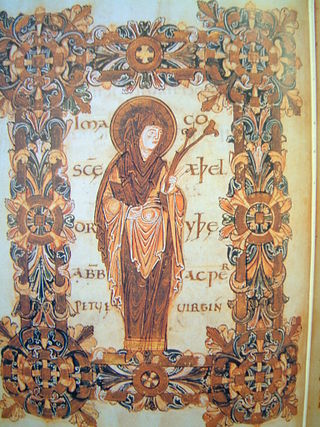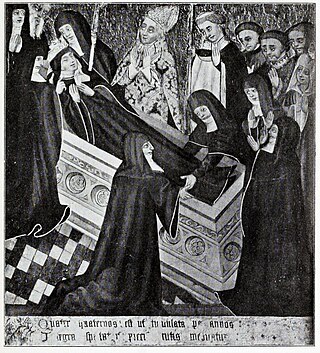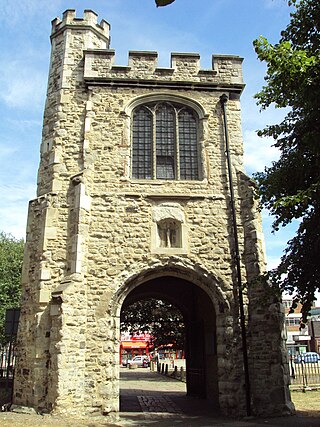Related Research Articles
Eanflæd was a Deiran princess, queen of Northumbria and later, the abbess of an influential Christian monastery in Whitby, England. She was the daughter of King Edwin of Northumbria and Æthelburg, who in turn was the daughter of King Æthelberht of Kent. In or shortly after 642 Eanflæd became the second wife of King Oswiu of Northumbria. After Oswiu's death in 670, she retired to Whitby Abbey, which had been founded by Hilda of Whitby. Eanflæd became the abbess around 680 and remained there until her death. The monastery had strong association with members of the Northumbrian royal family and played an important role in the establishment of Roman Christianity in England.

Æthelthryth was an East Anglian princess, a Fenland and Northumbrian queen and Abbess of Ely. She is an Anglo-Saxon saint, and is also known as Etheldreda or Audrey, especially in religious contexts. Her father was King Anna of East Anglia, and her siblings were Wendreda and Seaxburh of Ely, both of whom eventually retired from secular life and founded abbeys.

Werburgh was an Anglo-Saxon princess who became the patron saint of the city of Chester in Cheshire. Her feast day is 3 February.

Anna was king of East Anglia from the early 640s until his death. He was a member of the Wuffingas family, the ruling dynasty of the East Angles, and one of the three sons of Eni who ruled the kingdom of East Anglia, succeeding some time after Ecgric was killed in battle by Penda of Mercia. Anna was praised by Bede for his devotion to Christianity and was renowned for the saintliness of his family: his son Jurmin and all his daughters – Seaxburh, Æthelthryth, Æthelburh and possibly a fourth, Wihtburh – were canonised.

Hilda of Whitby was a Christian virgin and saint of the Roman Catholic Church. She was the founder and first abbess of the monastery at Whitby which was chosen as the venue for the Synod of Whitby in 664. An important figure in the Christianisation of Anglo-Saxon England, she was abbess in several convents and recognised for the wisdom that drew kings to her for advice.
A double monastery is a monastery combining separate communities of monks and of nuns, joined in one institution to share one church and other facilities. The practice is believed to have started in the East at the dawn of monasticism. It is considered more common in the monasticism of Eastern Christianity, where it is traceable to the 4th century. In the West the establishment of double monasteries became popular after Columbanus and sprang up in Gaul and in Anglo-Saxon England. Double monasteries were forbidden by the Second Council of Nicaea in 787, though it took many years for the decree to be enforced. Double monasteries were revived again after the 12th century in a significantly different way when a number of religious houses were established on this pattern among Benedictines and possibly the Dominicans. The 14th-century Bridgittines were purposely founded using this form of community.

Seaxburh, also Saint Sexburga of Ely, was a Queen as well as an abbess, and is a saint of the Christian Church. She was married to King Eorcenberht of Kent.

In the seventh century the pagan Anglo-Saxons were converted to Christianity mainly by missionaries sent from Rome. Irish missionaries from Iona, who were proponents of Celtic Christianity, were influential in the conversion of Northumbria, but after the Synod of Whitby in 664, the Anglo-Saxon church gave its allegiance to the Pope.

Cynethryth was a Queen of Mercia, wife of King Offa of Mercia and mother of King Ecgfrith of Mercia. Cynethryth is the only Anglo-Saxon queen consort in whose name coinage was definitely issued.

Barking Abbey is a former royal monastery located in Barking, in the London Borough of Barking and Dagenham. It has been described as having been "one of the most important nunneries in the country".
Saint Edburga of Minster-in-Thanet was a princess of Wessex, and abbess of Minster-in-Thanet. She is regarded as a saint.

Saint Ælfflæd (654–714) was the daughter of King Oswiu of Northumbria and Eanflæd. She was abbess of Whitby Abbey, an abbey of nuns that were known for their skills in medicine, from the death of her kinswoman Hilda in 680, first jointly with her mother, then alone. Ælfflæd was particularly known for her skills in surgery and her personal attention to patients, as was Hilda, who was known for her personalized medical care.
Hartlepool Abbey, also known as Heretu Abbey, Hereteu Abbey, Heorthu Abbey or Herutey Abbey, was a Northumbrian monastery founded in 640 CE by Hieu, the first of the saintly recluses of Northumbria, and Aidan of Lindisfarne, on the Headland Estate of Hartlepool now called the Heugh or Old Hartlepool, in County Durham, England.
Kyneburga, Kyneswide and Tibba were female members of the Mercian royal family in 7th century England who were venerated as saints.

Domne Eafe, also Domneva, Domne Éue, Æbbe, Ebba, was, according to the Kentish royal legend, a granddaughter of King Eadbald of Kent and the foundress of the double monastery of Minster in Thanet Priory at Minster-in-Thanet during the reign of her cousin King Ecgberht of Kent. A 1000-year-old confusion with her sister Eormenburg means she is often now known by that name. Married to Merewalh of Mercia, she had at least four children. When her two brothers, Æthelred and Æthelberht, were murdered she obtained the land in Thanet to build an abbey, from a repentant King Ecgberht. Her three daughters all went on to become abbesses and saints, the most famous of which, Mildrith, ended up with a shrine in St Augustine's Abbey, Canterbury.
The Kentish Royal Legend is a diverse group of Medieval texts which describe a wide circle of members of the royal family of Kent from the 7th to 8th centuries AD. Key elements include the descendants of Æthelberht of Kent over the next four generations; the establishment of various monasteries, most notably Minster-in-Thanet; and the lives of a number of Anglo-Saxon saints and the subsequent travels of their relics. Although it is described as a legend, and contains a number of implausible episodes, it is placed in a well attested historical context.

Cwenburh of Wimborne was an 8th-century Anglo-Saxon saint, a sister of King Ine of Wessex and of Saint Cuthburh. Her sister Cuthburh was married to King Aldfrith of Northumbria and then became the first abbess of Wimborne monastery.

Hildelith of Barking, also known as Hildilid or Hildelitha, was an 8th-century Christian saint, from Anglo-Saxon England but was of foreign origin.
Wulfhilda, also known as Wulfhild and Wulfreda among several other names, was an Anglo-Saxon abbess who is venerated as a saint in the Catholic Church.
Saint Lewina was a British virgin and martyr who was put to death by Saxon invaders. Her feast day is 24 July.
References
- ↑ Bede, Historia Ecclesiastica Gentis Anglorum, lib. iv, c. 23.
- ↑ Archaeologia Aeliana, xix, 47.
- ↑ Lina Eckenstein, Woman Under Monasticism (CUP 1972) p88.
- ↑ Michael Lapidge, & Helmut Gneuss, Learning and Literature in Anglo-Saxon England: Studies Presented to Peter Clemoes on the Occasion of His Sixty-fifth Birthday (Cambridge University Press, 1985) page 8.
- ↑ Susan G. Bell, Women, from the Greeks to the French Revolution, (Stanford University Press, 1980) page 103.
- ↑ Agnes Dunbar, A Dictionary of Saintly Women (1904).
- ↑ "Saint Hieu". CatholicSaints.Info. 6 August 2009. Retrieved 17 February 2018.
- ↑ September 2/September 15. Orthodox Calendar (PRAVOSLAVIE.RU).